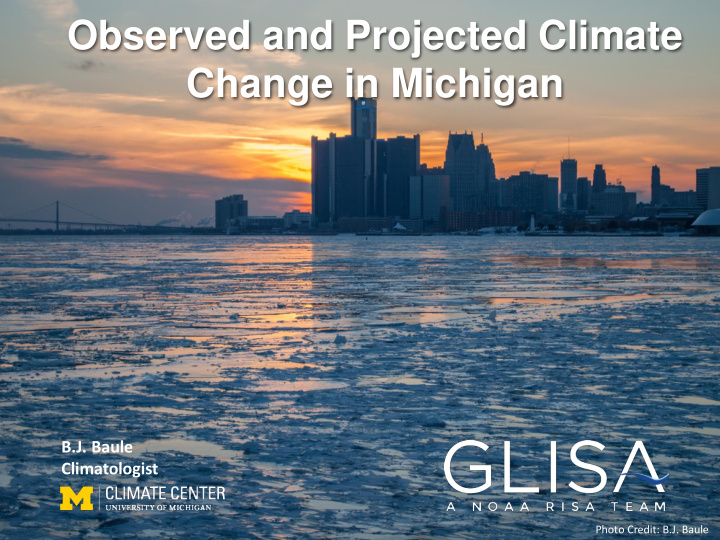



Observed and Projected Climate Change in Michigan B.J. Baule Climatologist Photo Credit: B.J. Baule
Climate on Global to Local Scales Global trends are more certain than regional or local trends. Local factors can drastically alter the magnitude of climate change impacts, but can also be adapted to more readily.
Adaptation and Mitigation Projected Global Average Temperature Adaptation Mitigation
What’s in a degree?
Rising Temperatures Future Observed 1.9 ° F 4 to 6 ° F Warmer Warmer 1951-2014 2041-2070 Source: GLISA and Third National Climate Assessment
Winters are warming faster. 1.9°F increase averaged over the entire year 3.2°F increase during winter (December – February) Source: GLISA and Third National Climate Assessment
A Longer Freeze-free Season Future Observed Observed changes due mostly to earlier last winter freeze 11 Days Longer 30 to 70 Days 1951-2014 Longer 2070-2099 Source: GLISA and Third National Climate Assessment
Observed Snowfall 1961-1990 Average 1981-2010 Average More here Less here Snowfall has generally increased across the Northern Midwest, remained stable in the central latitudes, and has decreased in the southern areas. From MRCC
More Precipitation Total annual precipitation has increased by: 8.9% Not even across the state. Has increased most in SE MI (+17%). Decreased over the Western UP (-6%) Changes are calculated from linear best fits of annual totals from 1951-2014. Source: National Climatic Data Center
Projected Precipitation Annual +5 to 20% Winter +10 to 30% Spring +0 to +30% Summer -10 to 0% Fall +0 to +30% NOAA NCDC / CICS-NC
Precipitation Impacts: Seasonal Changes and Water Supply Changing Seasonal Precipitation: Warmer springs and more precipitation increase the potential for mixed precipitation and variable spring weather. Summer Water Availability: Even as annual total precipitation increases, summers may become drier.
More Problem Precipitation 1.25-inch Precipitation Days: 25% Nuisance flooding and minor damages are reported more frequently after these events Changes are calculated from linear best fits of annual totals from 1951-2014. Source: National Climatic Data Center
Extreme Heat and Humidity By mid-century, models project Michigan could see: 90°F Days 10-50 more days per year 95°F Days 5 to 20 more days per year But, it is unclear if there has been a significant observed change in hot days.
A Migrating Climate The climate future generations experience will be fundamentally different than the climate today. By the end of this century, Michigan summers will feel more like current summers in Arkansas. Courtesy UCS 2009, original work by Hayhoe et al.
In adapting to Climate Change… Cities can lead by example. Photo Credit: Dan Brown
Recommend
More recommend